Integration of Low-Resolution ALS and Ground-Based SfM Photogrammetry Data. A Cost-Effective Approach Providing an ‘Enhanced 3D Model’ of the Hound Tor Archaeological Landscapes (Dartmoor, South-West England)
Abstract
1. Introduction
2. Materials and Methods
2.1. Case Study and Existing Documentation of the Site
2.2. Airborne Laser Scanning (ALS) Data Evaluation
2.3. Acquiring Images for Structure from Motion (SfM) in the Residential Area and Spatial Recording
- 5–7 coded markers (CMs; their number corresponds with the extent of the section and the density of structures there) generated from Agisoft Photoscan (the software used for SfM processing, Professional Edition, version 1.4.0). The CMs were printed on A3 paper size sheets and put onto the cardboard/hard paper to avoid their deformation on the ground and to ensure they are stable during the spatial recording (Figure 7a). As the wind was strong during the day and small nails did not work well in these weather conditions, all of them were loaded with different kind of weights (small stones, coins) so that the encoded graphic element is not disturbed and the marker is fixed at the particular place during the shooting. Their advantage lies in the fact that precise centres of the CMs are automatically detected in Agisoft Photoscan. This means that the spatial error is limited and working time during the evaluation decreases radically [13] (pp. 143–144). As the CMs are primarily used for the model georeferencing into a specific coordinate system (British National Grid after post-processing), they were distributed to cover the entire documented area as evenly as possible. For this purpose, at least 3–4 GCPs were necessary, so we used more than sufficient number of CMs in case that some of them would not be recognized because of: a) insufficient photo coverage and quality; b) a displacement by strong wind or many tourists walking through the site; c) damage by unexpected rain occurring during the day, which is typical for weather in Dartmoor.
- 5–7 more permanent points (check points–CPs) represented by measuring nails put into the ground and marked by a chalk spray for their better visibility and easier identification in the photos (Figure 7b). They have dual-purpose: (a) primarily for testing the 3D model precision, as an independent control and for the validation of the 3D model (see Section 2.6.); (b) they were also placed there as a safeguard if the georeferencing using CMs failed for any reason (see above). The CPs were placed in variable positions, usually in the areas among the CMs, several of them intentionally in distinctive lower or upper positions (e.g., top of the walls) to make sure that deformations in the 3D model would not occur [47], see below).
- Pole photography. The residential area was recorded by DSLR camera on the pole; the aluminium roller extension pole was used (1.2–2.4 m long, commonly used for painting) with a screw at the end where an Adapter for Painter’s Poles with a mount for a DSLR camera was placed to fix the camera (Figure 7c). The individual exposures were taken with a remote wireless trigger (controlled by a photographer) whenever the camera was in the ideal location for a suitable shot. For the image recording, a systematic methodology of several parallel passages was applied while walking in the longitudinal direction of the walls and also on the walls of preserved houses; a maximum distance of 4 m apart separated the individual passages, so for each section at least four passages were necessary. Images were recorded in ca. 1 m intervals. When standing on the walls (0.5–1.2 m), the surface was documented from the height of approx. 3.5 m; dimensions of the recorded areas are ca. 8 × 5 m (Figure 7e). In each position, a space was recorded in front of the operator holding the pole (to avoid shooting his own legs) and then an image from the original location to the left and to the right were taken, where it was possible to reach the pole; this ensured the utmost image overlay and multiple coverage of the large area from different points of view and angles. Our effort was to avoid doing entirely vertical images as they are not recommended for SfM due to the creation of a systematic mistake caused by a camera calibration error [48,49]). Therefore, images were slightly oblique (ca. 10°).
- Handheld photography. This was used for the full coverage at the site, primarily focused on the vertical elements (usually facing the masonry) which are not visible in the images taken from the pole at a large angle and from inappropriate positions (Figure 7d,f). The coverage of the documented section by these images ensures proper photo composition, and thus better interconnection of images to complete the three-dimensional capture of all elements at the site which are documented with higher precision (the complete 3D model can be generated instead as ‘ortho’ view only; Figure 8e). Additionally, handheld photos were used as redundancy for possible problems of later computation (e.g., blurry images from the pole, potential incomplete coverage by images of particular areas, etc.).
2.4. SfM Point Cloud Generation of the Residential Area
- The images with the lowest quality (e.g., blurry photos) were removed (Estimate Image Quality). Only a negligible number of images from the total collection was not used.
- In the workflow, images were aligned (Align Photos) in the highest accuracy (Generic preselection and Adaptive camera model fitting were on; key point limit: 50,000, tie point: 5,000). Total machine time was about 1h. As a result, the sparse point cloud was calculated (Figure 8c).
- Optimization of camera alignment by computed values from the lens calibration for refining and elimination of significant errors of reprojection. The entire chunk was then optimized according to all parameters from the lens calibration. The points were refined thanks to the familiar external and internal orientation of the camera. The calculation time was several seconds.
- Removing points with a high error of reprojection from the sparse point cloud (Gradual selection–Reprojection error–Reconstruction uncertainty). Calculation time only took dozens of seconds.
- Detecting the CMs (Tools–Markers–Detect Markers; Figure 8c). Only negligible number of targets had to be manually centred on the marker. The coordinates from GNSS were uploaded for each CM, and the projection of sparse point cloud was georeferenced into the coordinates (British_National_Grid WKID: 27700 Authority: EPSG), and RMSE was calculated (Update; see Section 2.5.). Calculation time was several minutes. CPs were manually found in the images, and their coordinates were exported to the .txt format.
- The Region was checked whether it was in the correct position, and the dense cloud was built (Build Dense Cloud, quality = medium; filtration algorithm = aggressive; Figure 8d,e). Calculation time was ca. 10h.
- Far margins of each dense cloud were cut out to ensure their continuous bonding and removing wrong overlays.
- At first, a DEM was built in Photoscan (automatically generated cell size = 0.0052 m).
- The DEM was exported as the .tiff format. The cell size was changed to 0.1 m.
- DEM (.tiff) was opened in ArcGIS (ArcMap 10.5.1). Using the Raster to point function, the regular grid of points cloud (0.1 m x 0.1 m) was generated. This point cloud consisted of 902,721 points in total.
- The Feature to 3D By Attribute enabled us to create 3D features using height values derived from the attribute of the input features, and thus the final point cloud used for the integration with ALS data was prepared (see Section 2.6.).
2.5. Accuracy Analysis and Validation of Outputs
- The edge of walls in the inner space of the cott/small house at the southern margin of the residential area was recorded using GNSS. The measured points corresponded precisely to the remains of the house in the DSM; there was no spatial deflection, the measurement had the same orientation, and the longest distance of points from the edge was within a few centimetres maximally.
- As the relief in several areas (formed by piles of material and disturbed surface) was not visible during the fieldwork because of dense bracken vegetation, we made 26 measurements by GNSS on one of these areas to compare the Z values with the DEM derived from modified point cloud of ALS data with 0.5 m cell size (see Section 2.2.). The results proved that the ALS data was located above the GNSS measurement (min = 1.52 cm, max = 45.57 cm, arithmetic mean = 21.74 cm, median = 23.61 cm). Additionally, ALS points adjacent to the furthest edge of the area documented by SfM were selected to explore the transition of both data sources. As the final SfM output consisted of the regular grid 0.1 m x 0.1 m, the maximal distance of the each ALS point was 7.07 cm (in the case it is exactly in the middle of the grid, however, the distance generally was lower: arithmetic mean = 4.03 cm). Then the elevation (Z values) of the nearest SfM and ALS points were compared. In total, 238 ALS points were assessed locating around the residential area. The results indicated that ALS data was placed slightly higher than the area documented by SfM photogrammetry (arithmetic mean = 14.1 cm, median = 14.7 cm).
2.6. Integration of ALS and SfM Point Clouds and the Generating of the Final 3D Models
- The 3D model including the residential area and the closest surroundings (422 × 355 m tile) only to ensure all buildings and structures documented by SfM were recorded in the highest possible detail. Due to the high resolution of the DEM interpolated from points in ArcMap, sharp transitions between ALS and SfM point clouds emerged in a few places (because of vegetation in the residential area and the vertical deflection between them, see Section 2.5.). This was apparent especially in the southern part where the mostly the flat relief of bare ground occurs. Therefore, the point cloud covering this area was first exported from ArcMap (ASCII format) and uploaded to Geomagic Wrap 2018 [54] allowing local smoothing through the creation of the polygon mesh. The smooth transition of data in problematic parts was thus ensured. Derived point cloud was then uploaded back to ArcMap (ASCII format) and interpolated into the DEM using Natural Neighbor algorithm; the cell size was 0.1 m. For the visualization of the earthworks and architectural debris, Local Relief Model (LRM) in planlauf/TERRAIN 2018 R2 software [55] was used (Figure 11a,b).
- The 3D model of the whole study area covering the complete hinterland and its surroundings (790 × 705 m tile). The final, merged point cloud was directly interpolated in ArcMap (Natural Neighbor algorithm) with a cell size of 0.25 m. For the visualization, the Sky-view Factor applied in RVT 1.3 [45,46], and LRM in planlauf/TERRAIN 2018 R2 software [55] were used (Figure 12a–c).
3. Results
4. Discussion
5. Conclusions
Author Contributions
Funding
Acknowledgments
Conflicts of Interest
Appendix A
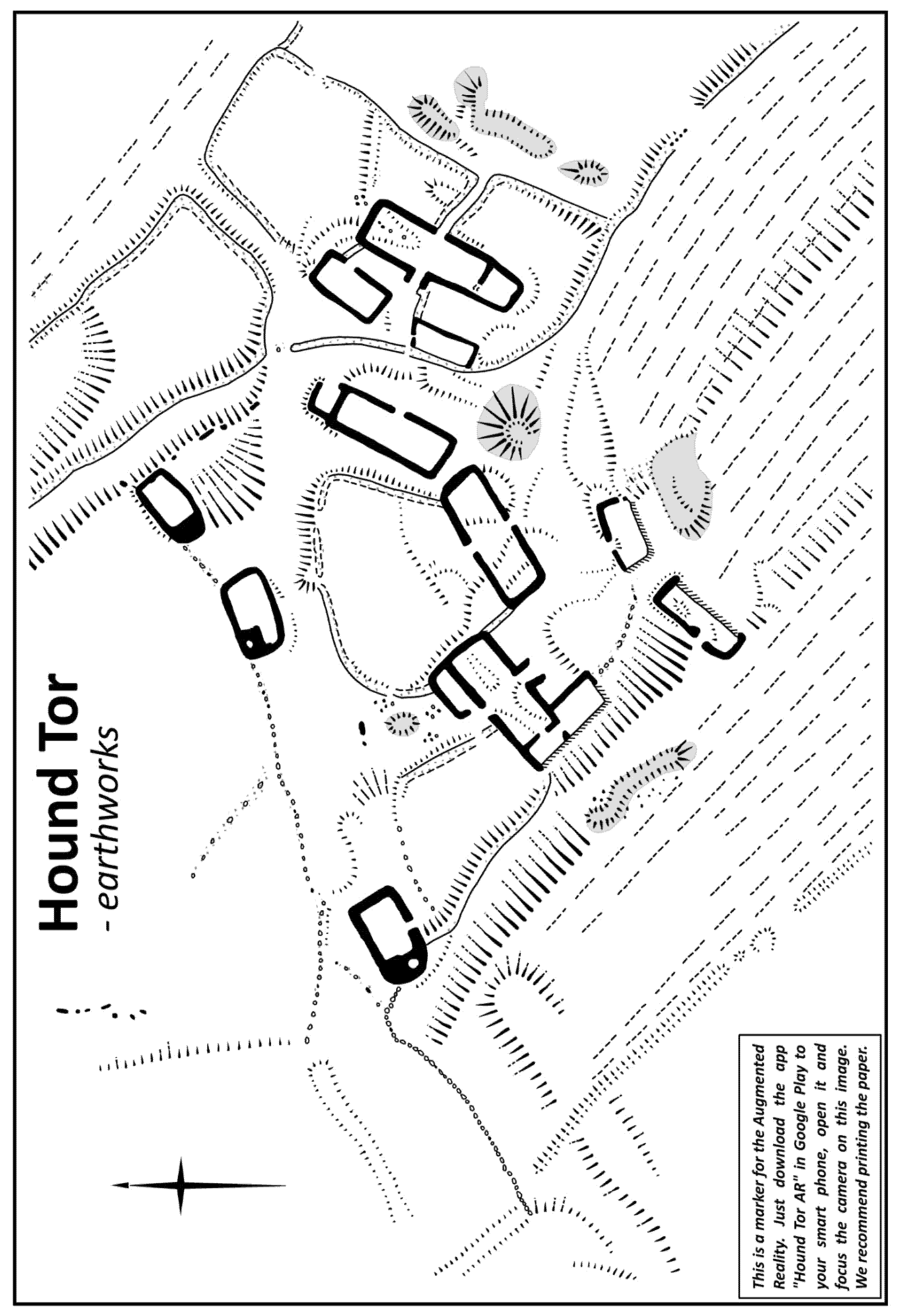
References
- Opitz, R.; Cowley, D. Interpreting Archaeological Topography: Airborne Laser Scanning, 3D Data and Ground Observation; Oxbow Books: Oxford, UK, 2013; ISBN 9781842175163. [Google Scholar]
- Hyyppä, H.; Yu, X.; Hyyppä, J.; Kaartinen, H.; Kaasalainen, S.; Honkavaara, E.; Rönnholm, P. Factors affecting the quality of DTM generation in forested areas. Int. Arch. Photogramm., Remote Sens. Spat. Inf. Sci. 2005, 36, 85–90. [Google Scholar]
- Bollandsås, O.M.; Risbøl, O.; Ene, L.T.; Nesbakken, A.; Gobakken, T.; Næsset, E. Using airborne small-footprint laser scanner data for detection of cultural remains in forests: An experimental study of the effects of pulse density and DTM smoothing. J. Archaeol. Sci. 2012, 39, 2733–2743. [Google Scholar] [CrossRef]
- Humme, A.; Lindenbergh, R.; Sueur, C. Revealing celtic fields from lidar data using kriging based filtering. In In Proceedings of the ISPRS Commission Symposium, Dresden, Germany, 25–27 September 2006. [Google Scholar]
- Liu, X. Airborne LiDAR for DEM generation: Some critical issues. Progr. Phys. Geogr. Intern. Rev. Geogr. Work Nat. Environ. Sci. 2008, 32, 31–49. [Google Scholar] [CrossRef]
- Liu, X.; Zhang, Z.; Peterson, J. Evaluation of the performance of DEM interpolation algorithms for LiDAR data. In Proceedings of the Surveying & Spatial Sciences Institute Biennial International Conference Adelaide 2009, Adelaide, Australia, 28 September–2 October 2009; Ostendorf, B., Baldock, P., Bruce, D., Burdett, M., Corcoran, P., Eds.; Surveying & Spatial Sciences Institute: Adelaide, Australia, 2009; pp. 771–780. [Google Scholar]
- Masini, N.; Coluzzi, R.; Lasaponara, R. On the airborne lidar contribution in archaeology: From site identification to landscape investigation. In Laser Scanning, Theory and Applications; Wang, C.-C., Ed.; IntechOpen: London, UK, 2011; pp. 263–290. ISBN 978-953-307-205-0. [Google Scholar]
- Doneus, M. Openness as visualization technique for interpretative mapping of airborne lidar derived digital terrain models. Remote Sens. 2013, 5, 6427–6442. [Google Scholar] [CrossRef]
- Kokalj, Ž.; Hesse, R. Airborne Laser Scanning Raster Data Visualization. A Guide to Good Practice; Založba ZRC: Ljubljana, Slovenia, 2017; Available online: https://iaps.zrc-sazu.si/sites/default/files/pkc014_kokalj.pdf (accessed on 6 January 2018).
- Risbøl, O.; Bollandsås, O.M.; Nesbakken, A.; Ørka, H.O.; Næsset, E.; Gobakken, T. Interpreting cultural remains in airborne laser scanning generated digital terrain models: Effects of size and shape on detection success rates. J. Archaeol. Sci. 2013, 40, 4688–4700. [Google Scholar] [CrossRef]
- Holata, L.; Plzák, J. Podstawowe prace z danymi pochodzącymi z lotniczego skanowania laserowego (opracowanie i ocena), możliwości ich testowania i ograniczenia w dokumentowaniu antropogenicznych form rzeźby terenu. In Lotnicze skanowanie laserowe jako narzędzie archeologii; Gojda, M., Kobyliński, Z., Eds.; Archaeologica Hereditas 11—Prace Instytutu Archeologii UKSW: Warsawa, Poland, 2018; pp. 23–44. ISBN 978-83-946496-6-1. [Google Scholar]
- Green, S.; Bevan, A.; Shapland, M. A comparative assessment of structure from motion methods for archaeological research. J. Archaeol. Sci. 2014, 46, 173–181. [Google Scholar] [CrossRef]
- Sapirstein, P. Accurate measurement with photogrammetry at large sites. J. Archaeol. Sci. 2016, 66, 137–145. [Google Scholar] [CrossRef]
- Olson, B.R.; Placchetti, R.A.; Quartermaine, J.; Killebrew, A.E. The Tel Akko Total Archaeology Project (Akko, Israel): Assessing the suitability of multiscale 3D field recording in archaeology. J. Field Archaeol. 2013, 38, 244–262. [Google Scholar] [CrossRef]
- Yravedra, J.; García-Vargas, E.; Maté-González, M.Á.; Aramendi, J.; Palomeque-González, J.F.; Vallés-Iriso, J.; Matesanz-Vicente, J.; González-Aguilera, D.; Domínguez-Rodrigo, M. The use of micro-photogrammetry and geometric morphometrics for identifying carnivore agency in bone assemblages. J. Archaeol. Sci. Rep. 2017, 14, 106–115. [Google Scholar] [CrossRef]
- De Reu, J.; De Smedt, P.; Herremans, D.; Van Meirvenne, M.; Laloo, P.; De Clercq, W. On introducing an image-based 3D reconstruction method in archaeological excavation practice. J. Archaeol. Sci. 2014, 41, 251–262. [Google Scholar] [CrossRef]
- Larsson, L.; Trinks, I.; Söderberg, B.; Gabler, M.; Dell’Unto, N.; Neubauer, W.; Ahlström, T. Interdisciplinary archaeological prospection, excavation and 3D documentation exemplified through the investigation of a burial at the Iron Age settlement site of Uppåkra in Sweden. Archaeol. Prospect. 2015, 22, 143–156. [Google Scholar] [CrossRef]
- Koutsoudis, A.; Vidmar, B.; Ioannakis, G.; Arnaoutoglou, F.; Pavlidis, G.; Chamzas, C. Multi-image 3D reconstruction data evaluation. J. Cult. Herit. 2014, 15, 73–79. [Google Scholar] [CrossRef]
- Verhoeven, G. Taking computer vision aloft—archaeological three-dimensional reconstructions from aerial photographs with photoscan. Archaeol. Prospect. 2011, 18, 67–73. [Google Scholar] [CrossRef]
- Verhoeven, G.; Doneus, M.; Briese, Ch.; Vermeulen, F. Mapping by matching: A computer vision-based approach to fast and accurate georeferencing of archaeological aerial photographs. J. Archaeol. Sci. 2012, 39, 2060–2070. [Google Scholar] [CrossRef]
- Eisenbeiss, H.; Zhang, L. Comparison of DSMs generated from mini UAV imagery and terrestrial laser scanner in a cultural heritage application. Int. Arch. Photogramm, Remote Sens. Spat. Inf. Sci. 2006, XXXVI-5, 90–96. [Google Scholar]
- Lambers, K.; Eisenbeiss, H.; Sauerbier, M.; Kupferschmidt, D.; Gaisecker, T.; Sotoodeh, S.; Hanusch, T. Combining photogrammetry and laser scanning for the recording and modelling of the Late Intermediate Period site of Pinchango Alto, Palpa, Peru. J. Archaeol. Sci. 2007, 34, 1702–1710. [Google Scholar] [CrossRef]
- Guidi, G.; Russo, M.; Ercoli, S.; Remondino, F.; Rizzi, A.; Menna, F. A multi-resolution methodology for the 3D modeling of large and complex archeological areas. Int. J. Arch. Comput. 2009, 7, 39–55. [Google Scholar] [CrossRef]
- Escarcena, J.C.; de Castro, E.M.; García, J.L.P.; Calvache, A.M.; del Castillo, T.F.; García, J.D.; Castillo, J.C. Integration of photogrammetric and terrestrial laser scanning techniques for heritage documentation. Virt. Arch. Rev. 2011, 2, 53–57. [Google Scholar] [CrossRef]
- Gonizzi Barsanti, S.; Remondino, F.; Visintini, D. 3D surveying and modeling of archaeological sites—some critical issues. ISPRS Ann. Photogramm. Remote Sens. Spatial Inf. Sci. 2013, II-5/W1, 145–150. [Google Scholar] [CrossRef]
- Lai, L.; Sordini, M. 3D documentation of a megalithic building in Sardinia. In Proceedings of the 18th International Conference on Cultural Heritage and New Technologies 2013 (CHNT 18, 2013), Wien, Austria, 11–13 November 2013; Börner, W., Uhlirz, S., Eds.; Museen der Stadt Wien—Stadtarchäologie: Wien, Austria, 2014. Available online: https://www.chnt.at/wp-content/uploads/Lai_Sordini_2014.pdf (accessed on 17 November 2017).
- Torres, J.A.; Hernandez-Lopez, D.; Gonzalez-Aguilera, D.; Moreno Hidalgo, M.A. A hybrid measurement approach for archaeological site modelling and monitoring: the case study of Mas D’Is, Penàguila. J. Archaeol. Sci. 2014, 50, 475–483. [Google Scholar] [CrossRef]
- Balletti, C.; Guerra, F.; Scocca, V.; Gottardi, C. 3D integrated methodologies for the documentation and the virtual reconstruction of an archaeological site. Int. Arch. Photogramm. Remote Sens. Spat. Inf. Sci. 2015, XL-5/W4, 215–222. [Google Scholar] [CrossRef]
- Chiabrando, F.; Spanò, A.; Sammartano, G.; Losè, L.T. UAV oblique photogrammetry and lidar data acquisition for 3d documentation of the Hercules Fountain. Virt. Arch. Rev. 2017, 8, 83–96. [Google Scholar] [CrossRef]
- Trinks, I.; Wallner, M.; Kucera, M.; Verhoeven, G.; Torrejón Valdelomar, J.; Löcker, K.; Nau, E.; Sevara, C.; Aldrian, L.; Neubauer, E.; Klein, M. Documenting bronze age Akrotiri on Thera using laser scanning, image-based modelling and geophysical prospection. Int. Arch. Photogramm. Remote Sens. Spat. Inf. Sci. 2017, XLII-2/W3, 631–638. [Google Scholar] [CrossRef]
- Franceschi, M.; Martinelli, M.; Gislimberti, L.; Rizzi, A.; Massironi, M. Integration of 3D modeling, aerial LiDAR and photogrammetry to study a synsedimentary structure in the Early Jurassic Calcari Grigi (Southern Alps, Italy). Eur. J. Remote Sens. 2015, 48, 527–539. [Google Scholar] [CrossRef]
- Kolzenburg, S.; Favalli, M.; Fornaciai, A.; Isola, I.; Harris, A.J.L.; Nannipieri, L.; Giordano, D. Rapid updating and improvement of airborne LIDAR DEMs through ground-based SfM 3-D Modeling of volcanic features. IEEE Trans. Geosci. Remote Sens. 2016, 54, 1–13. [Google Scholar] [CrossRef]
- Verhoeven, G.; Taelman, D.; Vermeulen, F. Computer vision-based orthophoto mapping of complex archaeological sites: the ancient quarry of Pitaranha (Portugal–Spain). Archaeometry 2012, 54, 1114–1129. [Google Scholar] [CrossRef]
- Galeazzi, F.; Moyes, H.; Aldenderfer, M. Defining best 3D practices in archaeology: Comparing laser scanning and dense stereo matching techniques for 3D intrasite data recording. Adv. Archaeol. Pract. 2014, 2, 353–365. [Google Scholar] [CrossRef]
- Wilkinson, M.W.; Jones, R.R.; Woods, C.E.; Gilment, S.R.; McCaffrey, K.J.W.; Kokkalas, S.; Long, J.J. A comparison of terrestrial laser scanning and structure-from-motion photogrammetry as methods for digital outcrop acquisition. Geosphere 2016, 12, 1865–1880. [Google Scholar] [CrossRef]
- Chandler, J.H.; Buckley, S. Structure from motion (SFM) photogrammetry vs terrestrial laser scanning. In Geoscience Handbook 2016: AGI Data Sheets, 5th ed.; Carpenter, M.B., Keane, C.M., Eds.; American Geosciences Institute: Alexandria, VA, USA, 2016; ISBN 978-0913312476. [Google Scholar]
- Beresford, G.; Brandon, P.; Linehan, C.D. Three deserted medieval settlements on Dartmoor: A report on the late E. Marie Minter’s excavations. Mediev. Archaeol. 1979, 23, 98–158. [Google Scholar] [CrossRef]
- Aston, M. Interpreting the Landscape. Landscape Archaeology and Local History; Routledge: London, UK; New York, NY, USA, 1985; ISBN 0-203-44212-1. [Google Scholar]
- Newman, P. The Field Archaeology of Dartmoor; English Heritage: Swindon, UK, 2011; ISBN 9781848020337. [Google Scholar]
- Allan, J. Medieval pottery and the dating of deserted settlement on Dartmoor. Devon Arch. Soc. Proc. 1994, 52, 141–147. [Google Scholar]
- Austin, D.; Walker, J.C. A new landscape context for Hound Tor. Med. Archaeol. 1985, 29, 147–152. [Google Scholar]
- Environmental open-data applications and datasets. Available online: http://environment.data.gov.uk/ds/survey/#/survey (accessed on 8 October 2017).
- Environment Agency LIDAR data. Available online: http://www.geostore.com/environment-agency/docs/Environment_Agency_LIDAR_Open_Data_FAQ_v5.pdf (accessed on 11 November 2017).
- LAStools, “Efficient LiDAR Processing Software” (Version 171231, Unlicensed). Available online: http://rapidlasso.com/LAStools (accessed on 23 November 2017).
- Zakšek, K.; Oštir, K.; Kokalj, Ž. Sky-view factor as a relief visualization technique. Remote Sens. 2011, 3, 398–415. [Google Scholar] [CrossRef]
- Relief Visualization Toolbox (RVT). Available online: https://iaps.zrc-sazu.si/en/rvt#v (accessed on 2 May 2017).
- Gonçalves, J.A.; Moutinho, O.F.; Rodrigues, A.C. Pole photogrammetry with an action camera for fast and accurate surface mapping. ISPRS Int. Arch. Photogramm. Remote Sens. Spat. Inf. Sci. 2016, XLI-B1, 571–575. [Google Scholar]
- Bemis, S.P.; Micklethwaite, S.; Turner, D.; James, M.R.; Akciz, S.; Thiele, S.T.; Bangash, H.A. Ground-based and UAV-Based photogrammetry: A multi-scale, high resolution mapping tool for structural geology and paleoseismology. J. Struct. Geosci. 2014, 69, 163–178. [Google Scholar] [CrossRef]
- James, M.R.; Robson, S. Mitigating systematic error in topographic models derived from UAV and ground-based image networks. Earth Surf. Process. Landf. 2014, 39, 1413–1420. [Google Scholar] [CrossRef]
- Wessling, R.; Maurer, J.; Krenn-Leeb, A. Structure from motion for systematic single surface documentation of archaeological excavations. In Proceedings of the 18th International Conference on Cultural Heritage and New Technologies 2013—CHNT 18, Vienna, Austria, 11–13 November 2013; Museen der Stadt Wien—Stadtarchäologie: Vienna, Austria, 2014. [Google Scholar]
- Prins, A.B. 3D Modeling for Archaeological Documentation: Using the JVRP Method to Record Archaeological Excavations with Millimeter-Accuracy. Available online: http://jezreelvalleyregionalproject.com/Prins-2016_3D-Modeling-for-Archaeological-Documentation_Version-3.0.pdf (accessed on 18 May 2018).
- Historic England. Photogrammetric Applications for Cultural Heritage. Guidance for Good Practice; Historic England: Swindon, UK, 2017; Available online: https://historicengland.org.uk/images-books/publications/photogrammetric-applications-for-cultural-heritage/ (accessed on 24 February 2018).
- Photoscan. Agisoft PhotoScan User Manual. Professional Edition, Version 1.4. 2018. Available online: http://www.agisoft.com/pdf/photoscan-pro_1_4_en.pdf (accessed on 13 January 2018).
- Geomagic Wrap. Available online: https://www.3dsystems.com/software/geomagic-wrap/free-trial (accessed on 8 April 2018).
- Planlauf GmbH. Available online: https://www.planlauf.com/en/planlaufterrain/ (accessed on 16 May 2018).
- Sktechfab. Available online: https://sketchfab.com/plzak/collections/hound-tor (accessed on 20 June 2018).
- Unity. Available online: https://unity3d.com/unity (accessed on 26 May 2018).
- Vuforia. Developer portal. Available online: https://developer.vuforia.com (accessed on 26 May 2018).
- ‘Hound Tor AR’ application in Google Play. Available online: https://play.google.com/store/apps/details?id=com.Archeodata.HoundTorAR (accessed on 28 May 2018).
- Unger, J.; Květina, P. An on-site presentation of invisible prehistoric landscapes. Int. Archaeol. 2017, 43. [Google Scholar] [CrossRef]
- Willis, M.D.; Koenig, C.W.; Black, S.L.; Castañeda, A.M. Archeological 3D mapping: the structure from motion revolution. J. Texas Arch. and Hist. 2016, 3, 1–36. [Google Scholar]
- Nadal-Romero, E.; Revuelto, J.; Errea, P.; López-Moreno, J.I. The application of terrestrial laser scanner and SfM photogrammetry in measuring erosion and deposition processes in two opposite slopes in a humid badlands area (central Spanish Pyrenees). Soil 2015, 1, 561–573. [Google Scholar] [CrossRef]
- Sevara, C.; Verhoeven, G.; Doneus, M.; Draganits, E. Surfaces from the visual past: Recovering high-resolution terrain data from historic aerial imagery for multitemporal landscape analysis. J. Archaeol Method Theory 2018, 25, 611–642. [Google Scholar] [CrossRef] [PubMed]
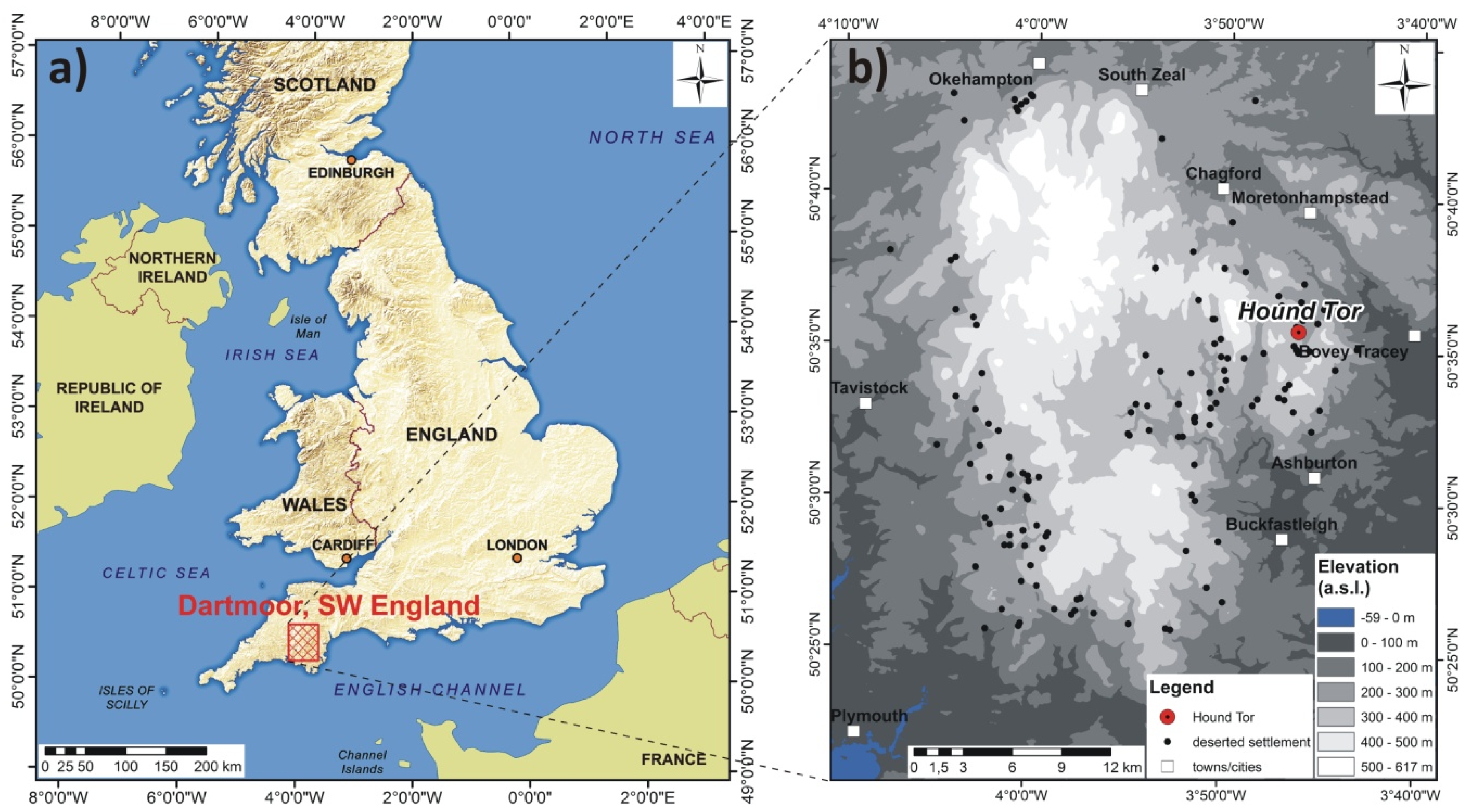
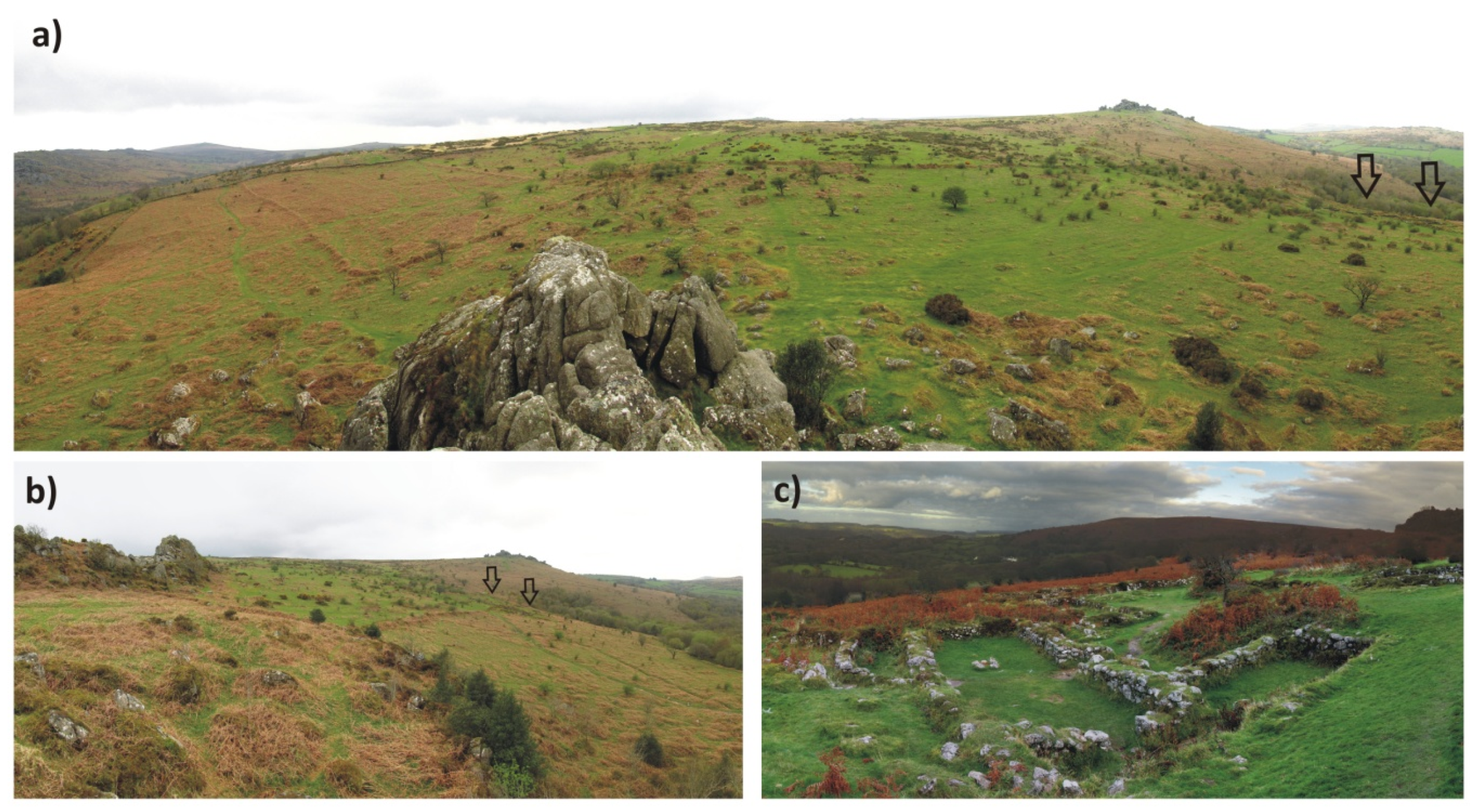
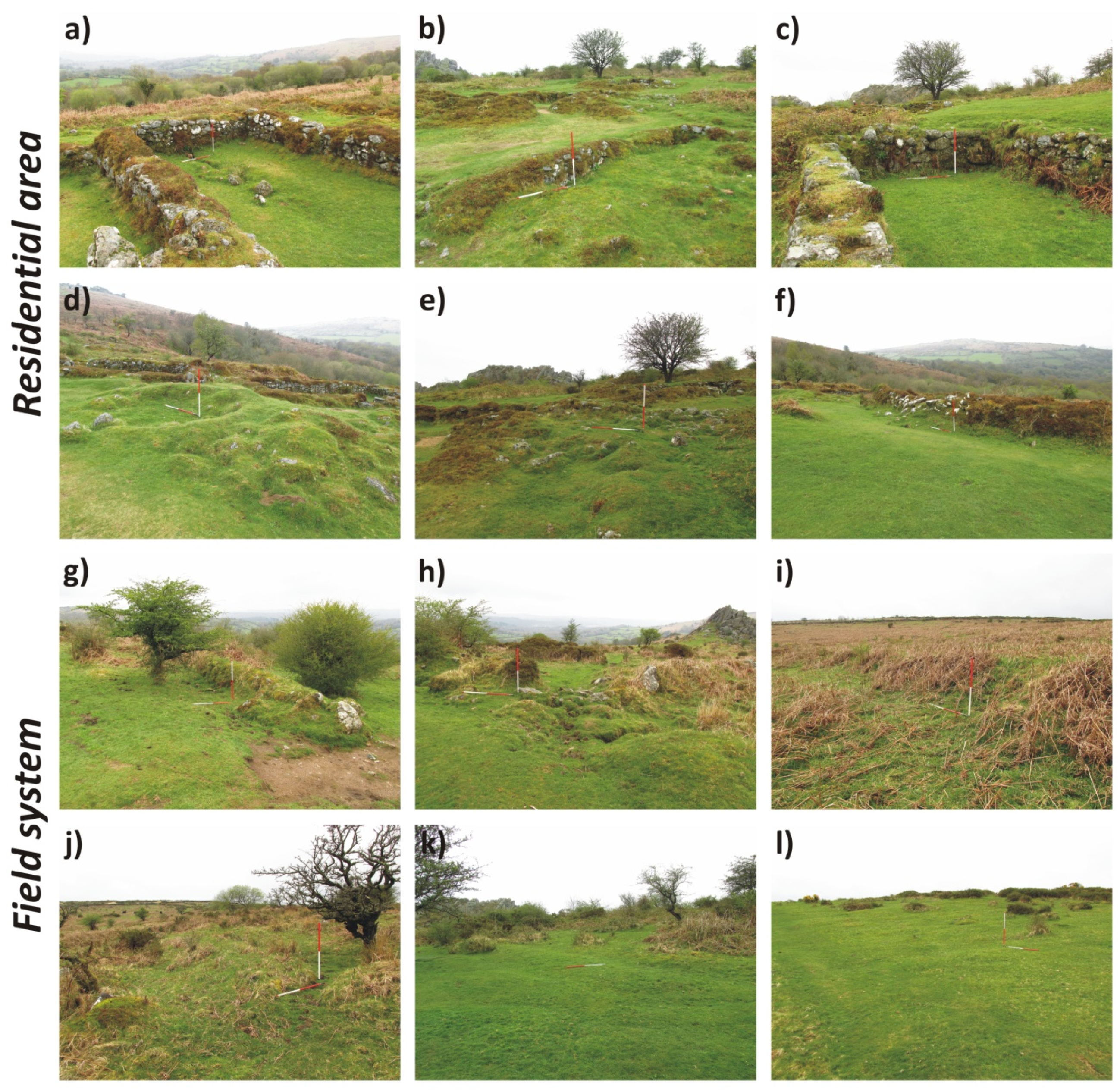
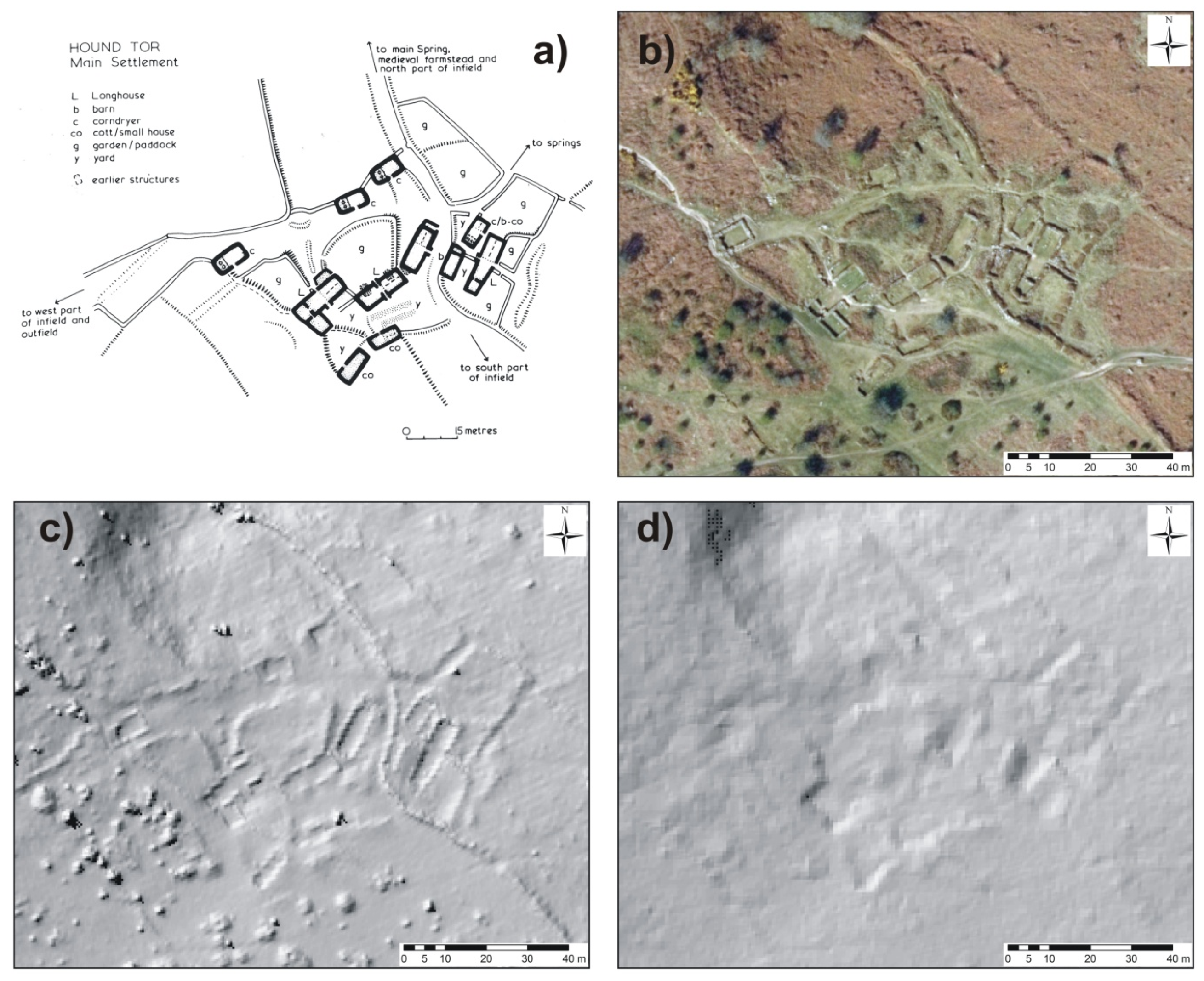
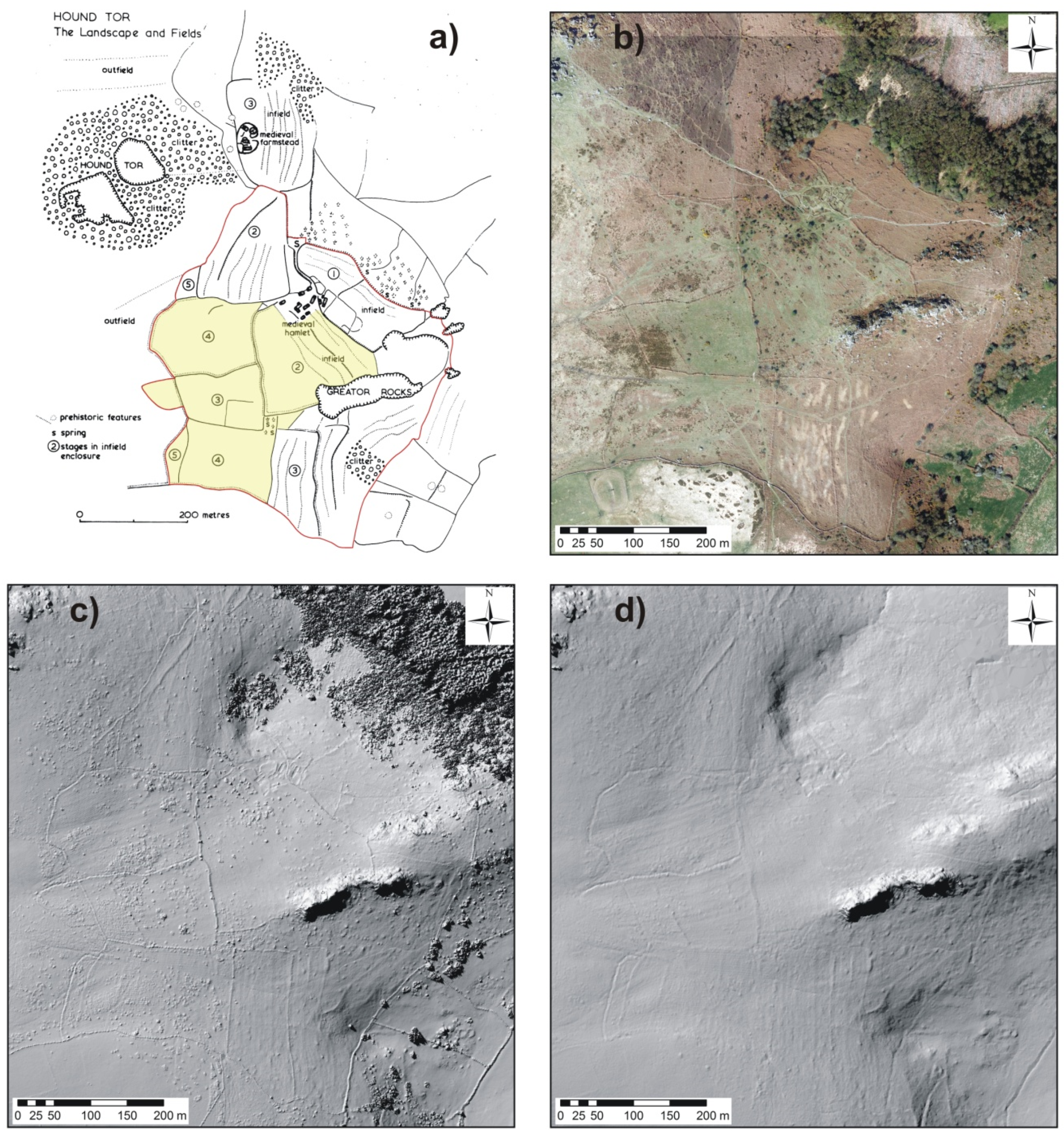
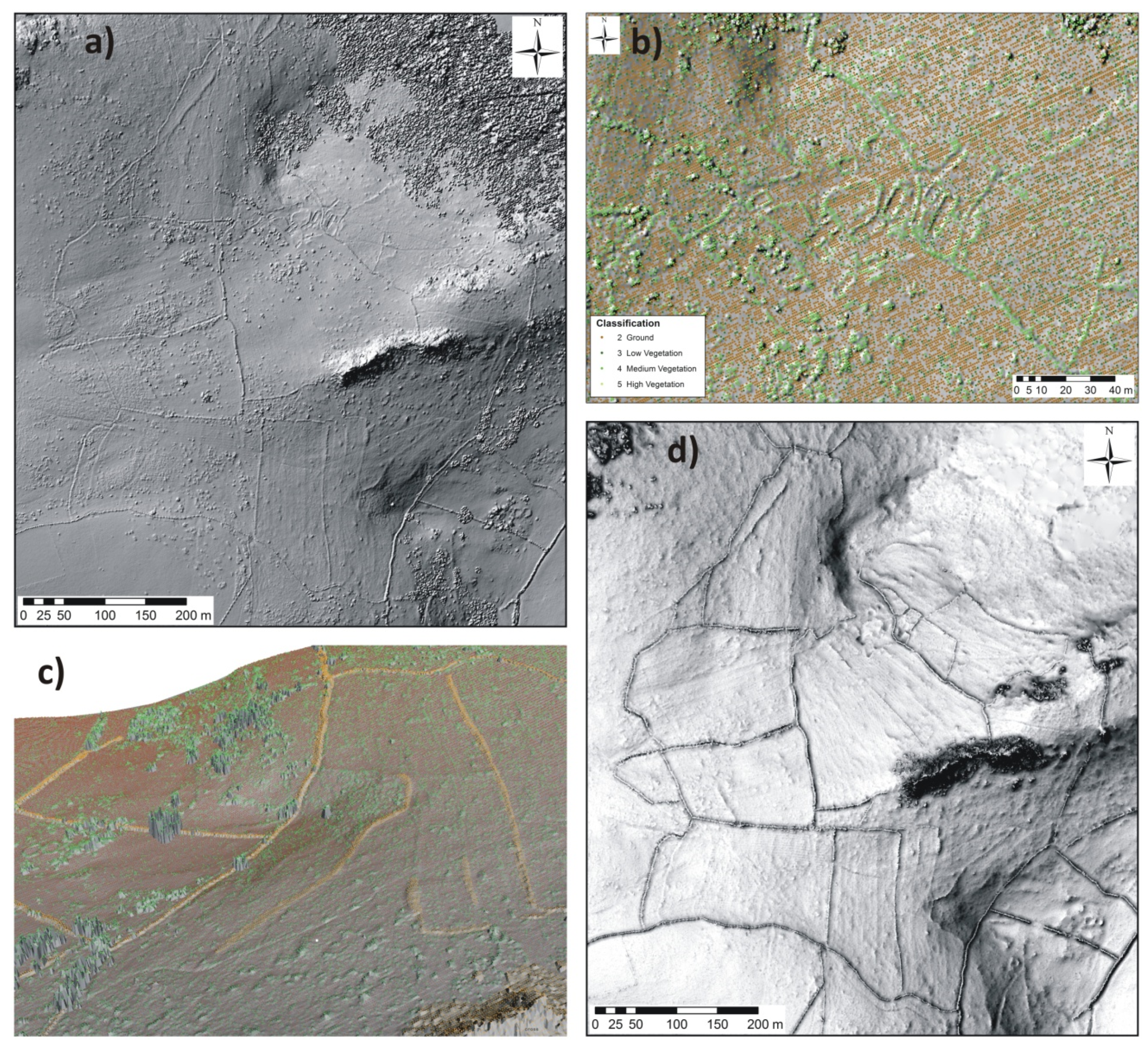
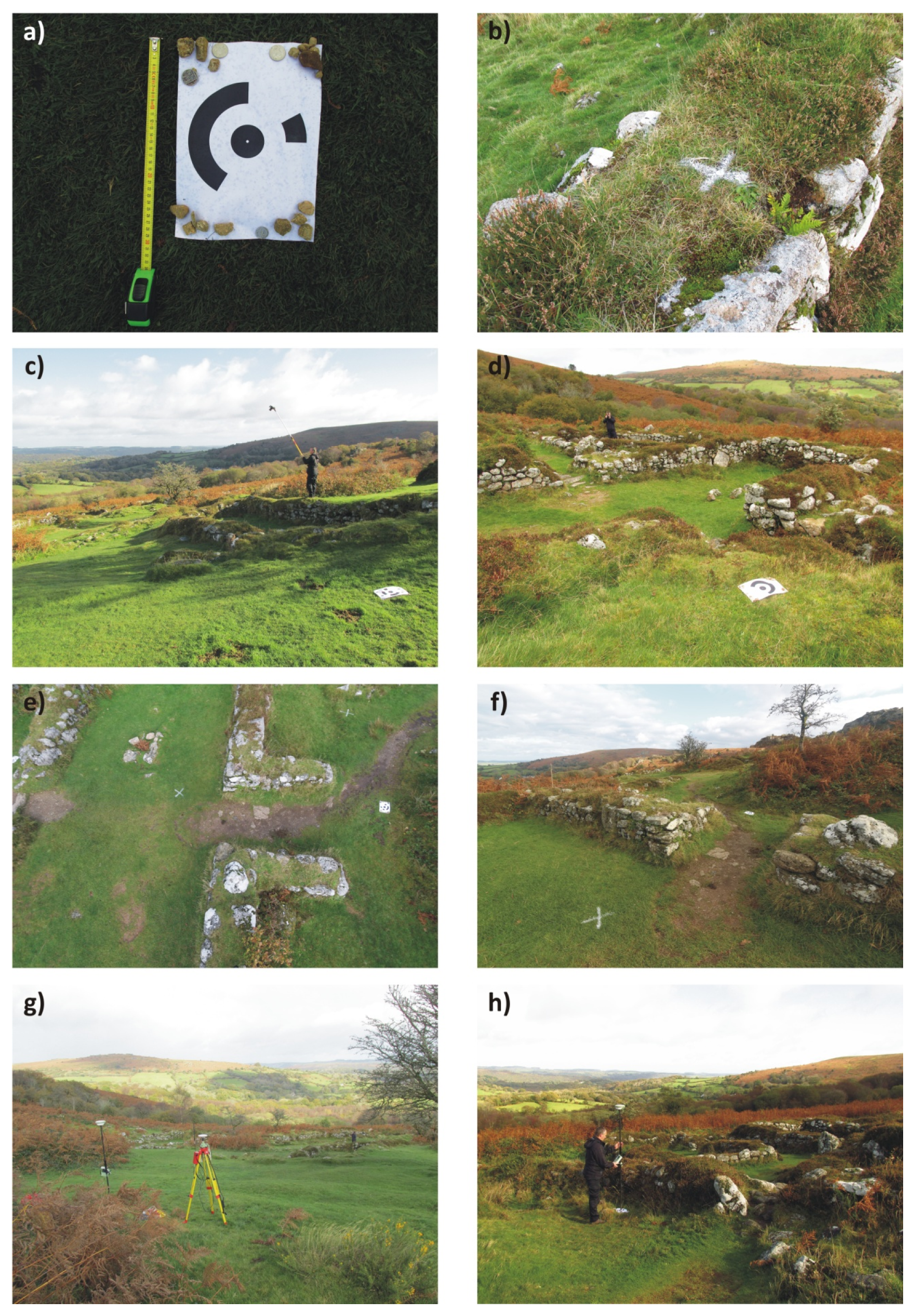
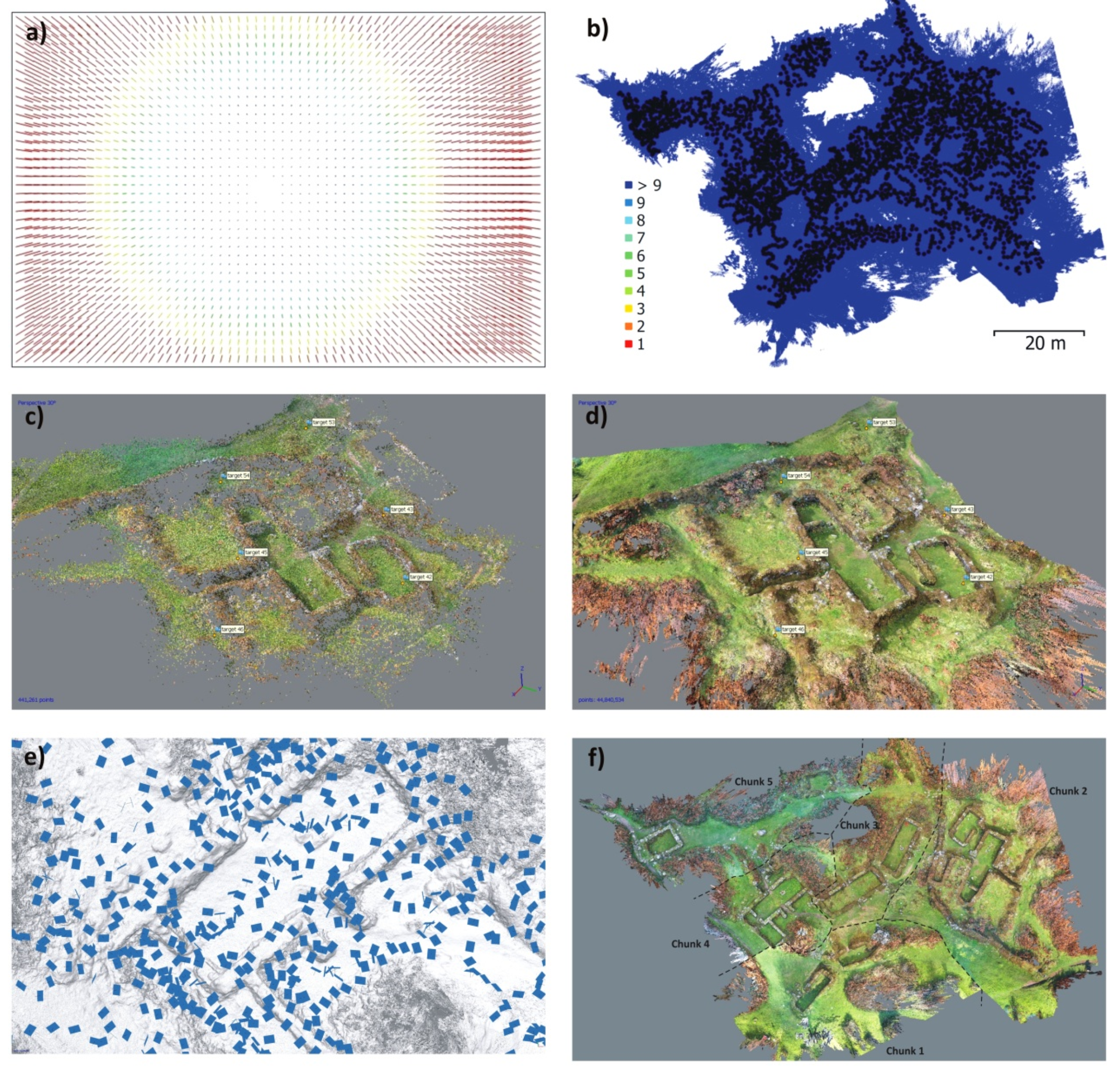
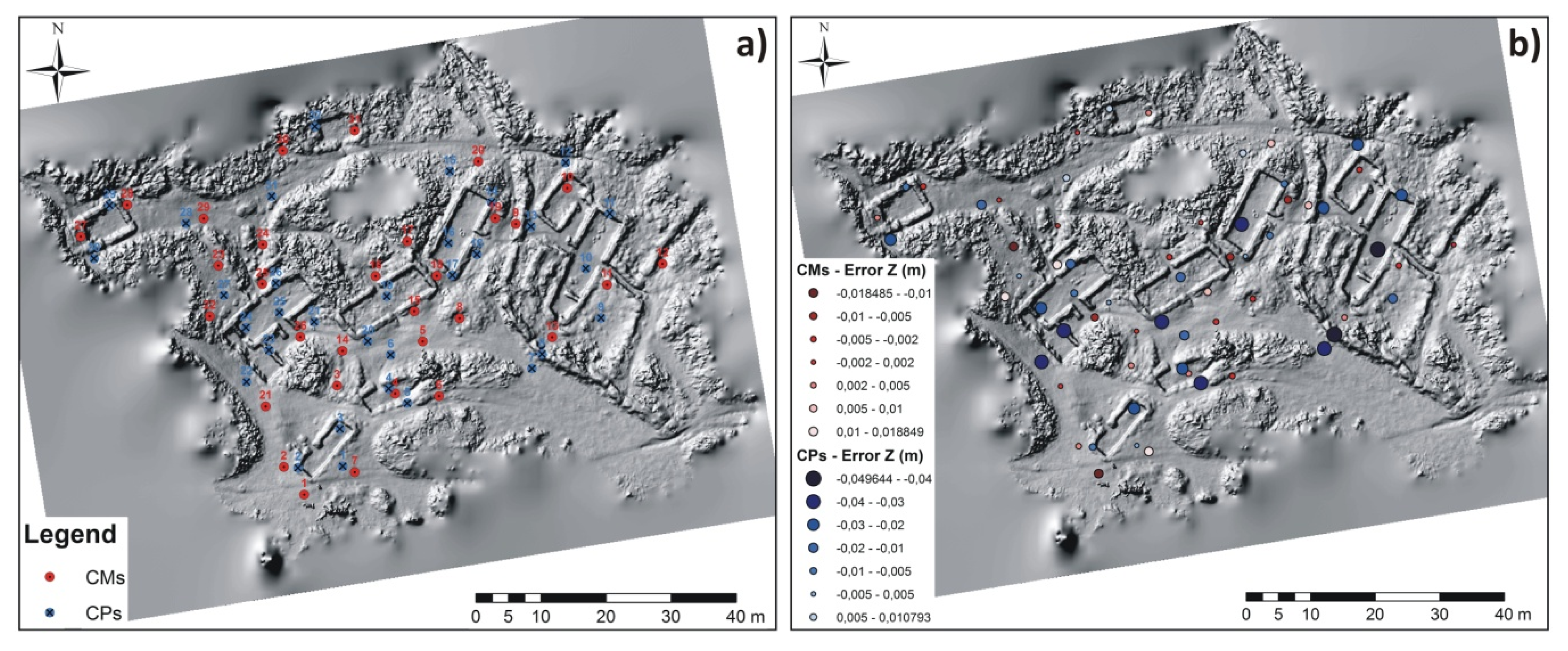
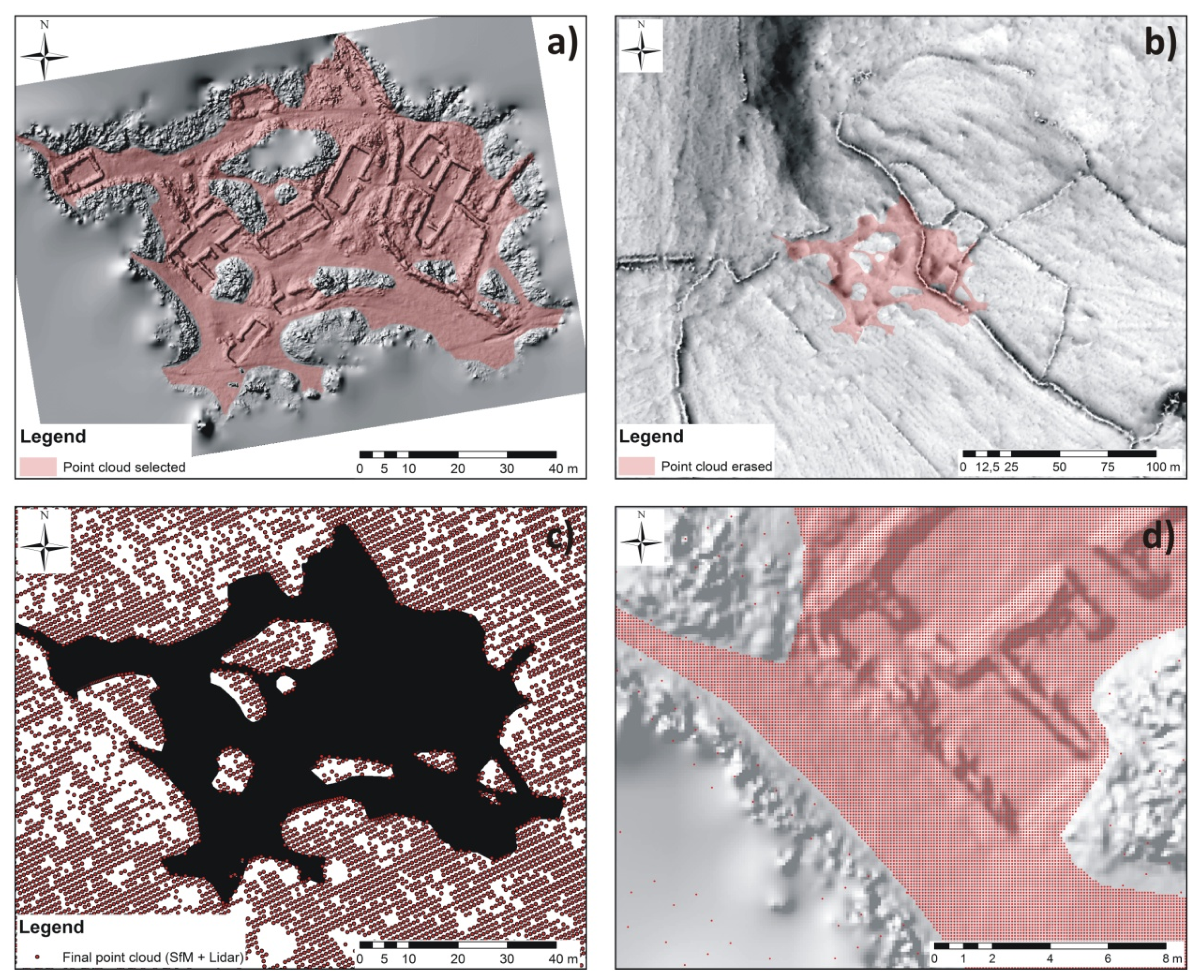
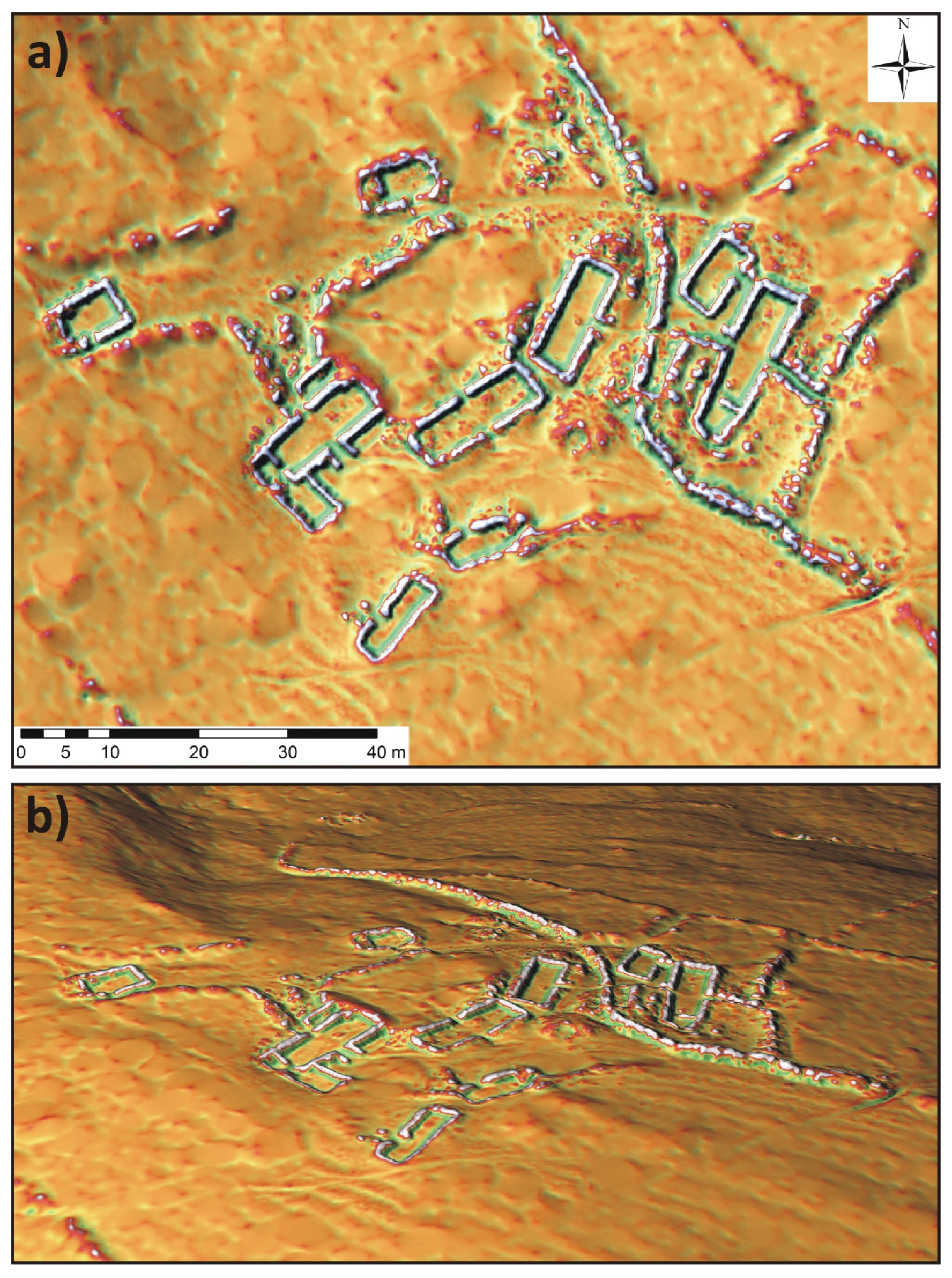
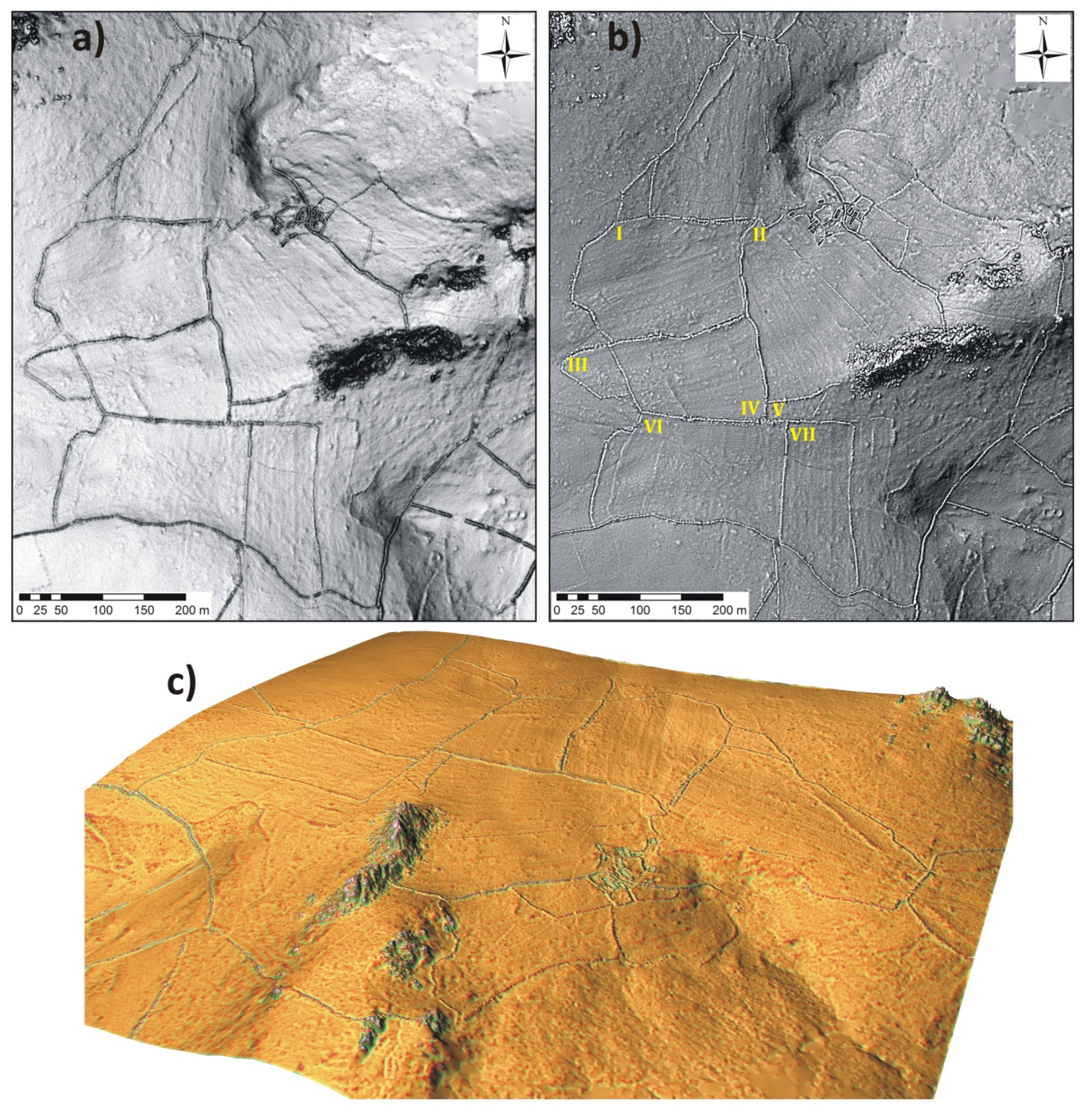
| Sections at the Site | Approx. Extent | Number of Photos: Pole | Number of Photos: Handheld | Total Number of Photos | Number of CMs | Number of CPs |
|---|---|---|---|---|---|---|
| 1 | 1020 m2 | 416 | 74 | 490 | 7 | 6 |
| 2 | 1430 m2 | 887 | 197 | 1,084 | 6 | 7 |
| 3 | 680 m2 | 593 | 144 | 737 | 7 | 7 |
| 4 | 550 m2 | 560 | 152 | 712 | 6 | 7 |
| 5 | 710 m2 | 423 | 112 | 535 | 5 | 5 |
| Total | 4390 m2 | 2,879 | 679 | 3,558 | 31 | 32 |
| CMs | Error X (m) | Error Y (m) | Error Z (m) | CPs | Error X (m) | Error Y (m) | Error Z (m) |
|---|---|---|---|---|---|---|---|
| 1 | 0.012722 | −0.001444 | −0.018485 | 1 | −0.002206 | 0.012299 | −0.003385 |
| 2 | 0.004321 | −0.000203 | 0.004298 | 2 | −0.001493 | 0.015249 | −0.005015 |
| 3 | −0.002848 | 0.002620 | 0.003133 | 3 | −0.004888 | 0.008884 | −0.021287 |
| 4 | −0.008928 | −0.012600 | 0.002677 | 4 | 0.007250 | 0.013403 | −0.028217 |
| 5 | 0.017943 | 0.009761 | −0.004914 | 5 | −0.013518 | 0.008935 | −0.036133 |
| 6 | −0.007940 | 0.004818 | −0.004678 | 6 | −0.002743 | 0.013753 | −0.016652 |
| 7 | −0.014808 | 0.001417 | 0.018849 | 7 | 0.002790 | 0.021699 | −0.035159 |
| 8 | 0.004527 | −0.000926 | −0.002286 | 8 | −0.013060 | 0.038725 | −0.049644 |
| 9 | 0.003244 | −0.008156 | 0.006763 | 9 | −0.000751 | 0.009348 | −0.012350 |
| 10 | 0.002956 | 0.003374 | −0.003273 | 10 | −0.008943 | −0.002943 | −0.044225 |
| 11 | −0.007973 | 0.001187 | −0.004331 | 11 | −0.011684 | −0.008504 | −0.026420 |
| 12 | 0.010111 | 0.008085 | 0.001041 | 12 | −0.007438 | 0.001591 | −0.022924 |
| 13 | −0.013549 | 0.002575 | 0.003983 | 13 | −0.026889 | 0.009393 | −0.023337 |
| 14 | −0.012069 | −0.002443 | 0.000698 | 14 | 0.006547 | −0.005556 | −0.005490 |
| 15 | 0.010430 | 0.004199 | 0.006233 | 15 | 0.007514 | −0.008262 | 0.010793 |
| 16 | 0.000882 | −0.005114 | −0.003871 | 16 | −0.007760 | −0.001662 | −0.031556 |
| 17 | 0.006373 | 0.007501 | −0.001733 | 17 | −0.003943 | −0.010442 | 0.000187 |
| 18 | 0.003335 | −0.019813 | −0.005111 | 18 | 0.004977 | 0.000327 | −0.009834 |
| 19 | −0.006779 | 0.008642 | −0.007748 | 19 | −0.003435 | −0.004528 | −0.017033 |
| 20 | 0.000195 | −0.008182 | 0.007781 | 20 | −0.012785 | −0.009234 | −0.030692 |
| 21 | −0.002373 | 0.005997 | −0.001159 | 21 | 0.002448 | 0.006591 | −0.000155 |
| 22 | −0.010529 | −0.010647 | 0.010706 | 22 | 0.013873 | −0.009720 | −0.033920 |
| 23 | 0.000338 | −0.000769 | −0.014007 | 23 | 0.007474 | −0.009854 | −0.030370 |
| 24 | 0.006075 | 0.001257 | 0.001129 | 24 | 0.000531 | 0.010894 | −0.021551 |
| 25 | 0.004642 | 0.001659 | 0.010871 | 25 | 0.007314 | 0.004758 | −0.007147 |
| 26 | 0.001151 | 0.005222 | −0.007016 | 26 | 0.013458 | −0.001372 | −0.014629 |
| 27 | 0.012696 | 0.005230 | 0.003918 | 27 | 0.006561 | −0.015128 | 0.001484 |
| 28 | −0.008455 | −0.002247 | −0.004956 | 28 | −0.008340 | 0.008177 | −0.014064 |
| 29 | −0.009628 | −0.013443 | 0.000742 | 29 | −0.010640 | 0.008699 | −0.009945 |
| 30 | 0.002606 | 0.018283 | −0.001709 | 30 | 0.016681 | −0.002395 | −0.021333 |
| 31 | 0.001082 | −0.005760 | 0.002588 | 31 | 0.007604 | −0.003604 | 0.006818 |
| 32 | 0.016585 | 0.002744 | 0.007693 | ||||
| RMSE | 0.008278 | 0.007710 | 0.007208 | RMSE | 0.009920 | 0.011502 | 0.022762 |
| RMSE XYZ | 0.013414 | RMSE XYZ | 0.027364 | ||||
© 2018 by the authors. Licensee MDPI, Basel, Switzerland. This article is an open access article distributed under the terms and conditions of the Creative Commons Attribution (CC BY) license (http://creativecommons.org/licenses/by/4.0/).
Share and Cite
Holata, L.; Plzák, J.; Světlík, R.; Fonte, J. Integration of Low-Resolution ALS and Ground-Based SfM Photogrammetry Data. A Cost-Effective Approach Providing an ‘Enhanced 3D Model’ of the Hound Tor Archaeological Landscapes (Dartmoor, South-West England). Remote Sens. 2018, 10, 1357. https://doi.org/10.3390/rs10091357
Holata L, Plzák J, Světlík R, Fonte J. Integration of Low-Resolution ALS and Ground-Based SfM Photogrammetry Data. A Cost-Effective Approach Providing an ‘Enhanced 3D Model’ of the Hound Tor Archaeological Landscapes (Dartmoor, South-West England). Remote Sensing. 2018; 10(9):1357. https://doi.org/10.3390/rs10091357
Chicago/Turabian StyleHolata, Lukáš, Jindřich Plzák, Radek Světlík, and João Fonte. 2018. "Integration of Low-Resolution ALS and Ground-Based SfM Photogrammetry Data. A Cost-Effective Approach Providing an ‘Enhanced 3D Model’ of the Hound Tor Archaeological Landscapes (Dartmoor, South-West England)" Remote Sensing 10, no. 9: 1357. https://doi.org/10.3390/rs10091357
APA StyleHolata, L., Plzák, J., Světlík, R., & Fonte, J. (2018). Integration of Low-Resolution ALS and Ground-Based SfM Photogrammetry Data. A Cost-Effective Approach Providing an ‘Enhanced 3D Model’ of the Hound Tor Archaeological Landscapes (Dartmoor, South-West England). Remote Sensing, 10(9), 1357. https://doi.org/10.3390/rs10091357






